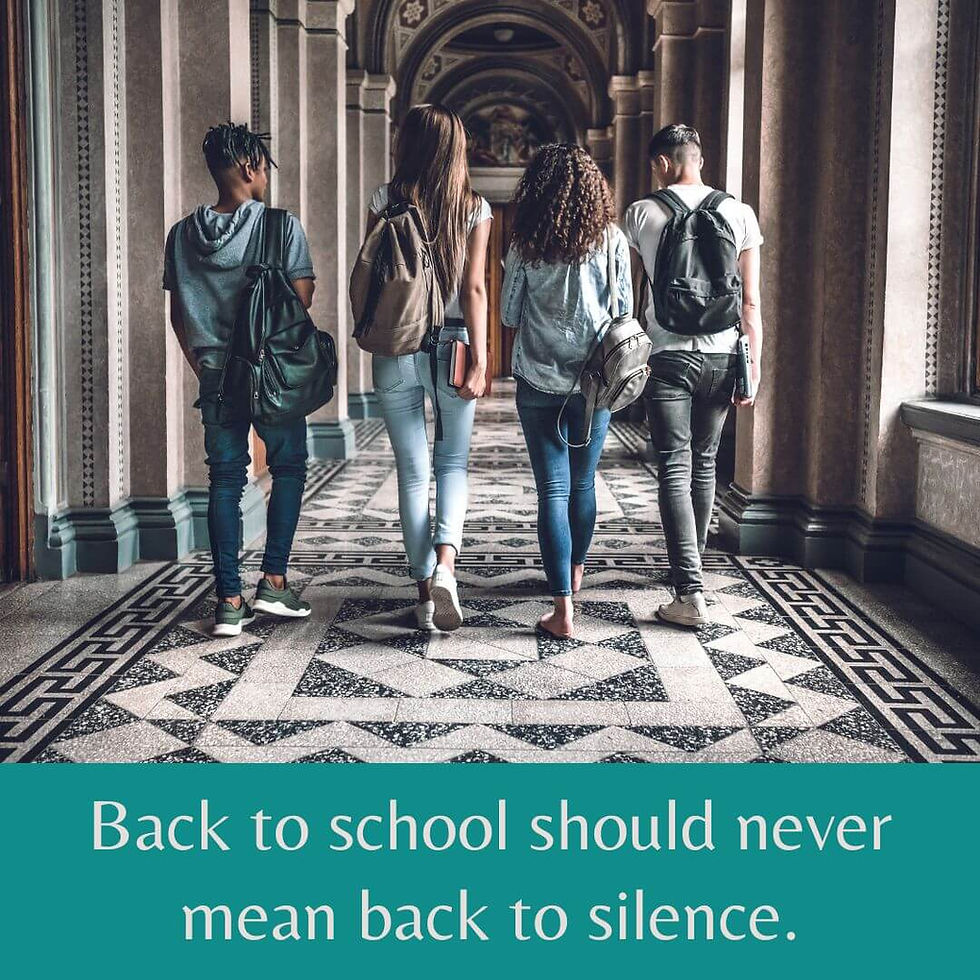Back to School, Not Back to Silence: Confronting Sexual Assault Through Awareness and Action
- SavaCenterGA
- Aug 12
- 4 min read
As backpacks are packed and calendars fill with back-to-school dates, most families are focused on logistics—school supplies, new routines, carpool plans, and class schedules. But amid the excitement, one critical topic often remains in the shadows: sexual assault awareness and prevention.
Whether it’s a middle schooler navigating social pressures, a high schooler attending their first party, or a college freshman away from home for the first time, students of all ages deserve to be safe, heard, and respected. As we return to classrooms and campuses this fall, let’s make one thing clear:
Back to school should never mean back to silence.

The Scope of the Problem
Sexual violence doesn’t only happen on college campuses—it begins much earlier. Research from the Centers for Disease Control and Prevention (CDC) shows that many survivors of sexual abuse first experience it during adolescence. According to RAINN (Rape, Abuse & Incest National Network), girls ages 16–19 are four times more likely than the general population to be victims of sexual assault.
On college campuses, the risks are even more concentrated. The first six to eight weeks of the academic year—commonly called the “Red Zone”—are the most dangerous time for sexual assaults, particularly for first-year students who are still adjusting to independence and unfamiliar environments.
But it’s not just college. Harassment, coercion, inappropriate touching, and digital exploitation are realities in elementary, middle, and high schools too. Unfortunately, many students don’t report what happens—due to fear, shame, mistrust of adults, or simply not knowing that what happened, wasn’t okay.
A Call to Action for Every Member of the School Community
Preventing sexual assault and supporting survivors isn’t just a college issue or a parent’s responsibility. It requires a united front of students, families, educators, administrators, coaches, counselors, and community leaders. Here’s what that looks like in action:
🎒 For Students: Knowledge Is Power
Know what consent means. Consent must be freely given, clearly communicated, enthusiastic, informed, and ongoing. If it's not a yes, it's a no—and silence is not consent.
Trust your gut. If something feels wrong, it probably is. You’re never overreacting by speaking up.
Use your voice and influence. Call out harmful jokes, support your peers, and know how to report something if you see or experience misconduct.
Understand boundaries—yours and others. Respect personal space, emotional comfort, and digital privacy.
👪 For Parents and Guardians: Start Conversations Early and Often
Talk to your children about respect, consent, and bodily autonomy—starting when they’re young and continuing through their teens and college years.
Create safe, judgment-free spaces where your child can come to you if they’re uncomfortable or afraid.
Model healthy relationships in your own behavior—how you handle conflict, boundaries, and communication matters.
Know the policies and resources at your child’s school or university. Stay engaged and ask questions when necessary.
🏫 For Educators and Coaches: Be a Trusted Adult
Watch for warning signs of trauma, abuse, or distress. Students often reveal more in their behavior than in their words.
Use inclusive, age-appropriate curriculum to teach students about relationships, consent, and digital safety.
Hold yourself accountable. Ensure your classroom, team, or club is free of harassment, favoritism, or unequal power dynamics.
Support students who report. Believe them. Respect their privacy. Help them access support without making it about you.
🏛️ For Administrators and School Leaders: Build a Culture of Accountability
Ensure your school or district has clear, visible reporting procedures that are age-appropriate and accessible to all students and families.
Provide ongoing, trauma-informed training to staff, including faculty, bus drivers, janitorial staff, cafeteria workers, and substitutes—not just once a year.
Take complaints seriously. Institutional cover-ups or dismissive responses erode trust and leave students vulnerable.
Include parents and community organizations in prevention efforts and build partnerships with local advocacy centers.
Digital Safety: The New Frontier
It’s not just about what happens in classrooms or dorm rooms. Online harassment, sextortion, revenge porn, and grooming are rapidly growing concerns for students of all ages. Parents and educators should help students understand:
The risks of sharing personal content online, even with people they trust.
That it’s okay to say “no” to digital pressure—whether it’s photos, messages, or interactions on apps.
That help is available if they’re being threatened, blackmailed, or harassed online.
If It Happens to You or Someone You Know
Know that:
You are not alone.
It is not your fault.
There is help.
If a child or student discloses abuse or assault:
Listen without judgment or interruption.
Believe them and thank them for telling you.
Don't press for details they’re not ready to share.
Help them access appropriate support—through school counselors, advocacy groups, or medical professionals.
Resources to Bookmark and Share
RAINN National Sexual Assault Hotline: 1-800-656-HOPE (4673) – www.rainn.org
National Child Abuse Hotline: 1-800-4-A-CHILD (1-800-422-4453) – www.childhelp.org
Love is Respect (for teens and young adults in relationships): www.loveisrespect.org
Stop It Now! (for parents and educators): www.stopitnow.org
National Center for Missing & Exploited Children (for reporting online abuse): www.cybertipline.org
Sexual Assault Victim’s Advocacy Center: 706-419-8775 www.savacenterga.org
Let’s Build a Safer School Year Together
Creating a culture where sexual assault is prevented—and survivors are supported—requires all of us. It starts with conversations, continues with education, and grows through action. Schools must be safe not just academically, but emotionally and physically.
This back-to-school season let’s pack more than school supplies.
Let’s pack courage.
Let’s pack compassion.
Let’s pack accountability.
Because every child and every student deserves more than an education. They deserve safety, dignity, and the unwavering belief that their voice matters.










